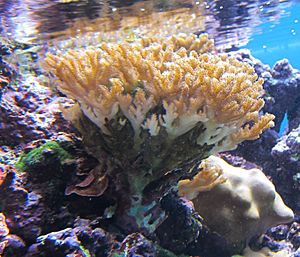Hawaiian reef coral facts for kids
Quick facts for kids Hawaiian reef coral |
|
|---|---|
 |
|
| Conservation status | |
| Scientific classification |
The Montipora dilatata, also known as the Hawaiian reef coral, is a type of coral. It belongs to the Acroporidae family. This coral is special because it is only found in the waters around Hawaii.
Contents
What Does the Hawaiian Reef Coral Look Like?
This coral can look very different from one place to another. It might grow as flat patches, plates, bumps, or even branches. The Montipora dilatata has a very smooth surface.
These corals are usually purple or brown. They can grow quite large, up to 3 feet (1 meter) wide!
You can only find this coral in the Hawaiian Islands. It lives in places like Kaneohe Bay on Oahu. It also lives in the Northwestern Hawaiian Islands (NWHI). These include Midway Atoll, Pearl and Hermes Atoll, Lisianski Island, Laysan Island, Maro Reef, and French Frigate Shoals.
Where Does the Hawaiian Reef Coral Live?
This coral needs calm, shallow water to grow. It lives in quiet lagoons and bays. It likes places where the water does not move too much.
Strong storms or tiny sea creatures can easily break this coral into pieces. But these broken pieces can grow into new coral colonies. This is a way they reproduce!
The Hawaiian reef coral used to be more common in Kaneohe Bay. It formed large patches on the reef flats. Now, it is very rare there.
Why Is the Hawaiian Reef Coral in Danger?
The number of Hawaiian reef corals has dropped a lot over time. In a survey done in 2000, only 3 colonies were found. This coral faces several threats:
- Warm Water: It is very sensitive to warm water. It was the first coral to turn white (bleach) during a heat event in Kaneohe Bay in 1996.
- Fresh Water and Low Tides: Too much fresh water or being exposed to air during very low tides can harm it.
- Pollution and Habitat Damage: Its home is being damaged by dirt settling on it (sedimentation) and pollution.
- Invasive Algae: Harmful types of algae, like Gracilaria salicornia and Dictyosphaeria cavernosa, are growing in Kaneohe Bay. These algae can take over the coral's space.
- Limited Home: This coral only lives in a few places, which makes it more vulnerable.
- Human Activities: Anchors, fish traps, swimmers, and divers can also damage the coral.
Protecting the Hawaiian Reef Coral
Scientists are also looking at other similar coral species. For example, M. turgescens at Kure Atoll and M. cf. dilatata at Maro Reef. They want to use genetic tests to see if these are truly different species.
The Hawaiian reef coral is listed as a "Species of Concern" by the U.S. National Marine Fisheries Service. This means the U.S. government is worried about its future. They don't have enough information yet to list it as endangered, but they are watching it closely.
It is against the law to collect coral in Hawaii's state waters without a special research permit. This rule helps protect the Hawaiian reef coral and other corals.


